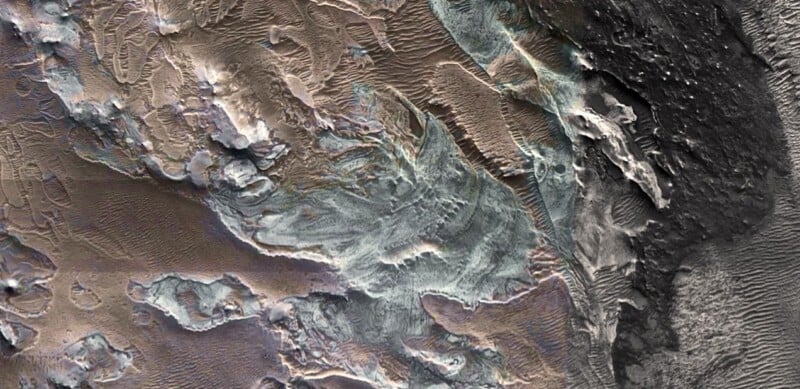Image of Ancient Glacier on Mars Raises Hopes for Human Exploration

The remains of a glacier on Mars have been discovered via the HiRISE camera attached to the Mars Reconnaissance Orbiter. If the ice is confirmed, it would have significant implications for humans who may land there one day.
The SETI Institute made the announcement on Wednesday. It released the image that features light-toned deposits consisting of sulfate salts, crevasse fields, and moraine bands that are signs of a “relict glacier.”
The glacier is estimated to be roughly four miles wide (six kilometerfs) and 2.5 miles long (four kilometers). The researchers hope that the discovery means that the planet was once more watery than previously thought.
“What we’ve found is not ice, but a salt deposit with the detailed morphologic features of a glacier,” says Dr. Pascal Lee, a planetary scientist with the SETI Institute and the Mars Institute, and the lead author of the study.
“What we think happened here is that salt formed on top of a glacier while preserving the shape of the ice below, down to details like crevasse fields and moraine bands.”

Volcanic Region
The area of Mars where the ancient glacier was spotted has a history of volcanic activity. When mixtures of volcanic ash and lava react with water, a hard, crusty salt layer can form.
“Where some of the volcanic materials came in contact with glacier ice, chemical reactions would have taken place at the boundary between the two to form a hardened layer of sulfate salts,” says study co-author Sourabh Shubham, a doctoral student of geology at the University of Maryland, College Park.
“This is the most likely explanation for the hydrated and hydroxylated sulfates we observe in this light-toned deposit.”
Over time, erosion may have removed the volcanic materials, and a crusty layer of sulfates mirroring the glacier ice underneath became exposed, which would explain how a salt deposit is now visible.
“Glaciers often present distinctive types of features, including marginal, splaying, and tic-tac-toe crevasse fields, and also thrust moraine bands and foliation. We are seeing analogous features in this light-toned deposit, in form, location, and scale. It’s very intriguing,” says John Schutt, a geologist at the Mars Institute, experienced icefield guide in the Arctic and Antarctica, and a co-author of the study.
Whether ice is preserved beneath the light-toned deposits remains to be seen but the study draws comparisons with the salt lakebeds of the Altiplano in South America where old glacier ice has remained protected underneath blankets of salts.
Water on Mars would be a game-changer for human exploration of the planet.
“The desire to land humans at a location where they might be able to extract water ice from the ground has been pushing mission planners to consider higher latitude sites,” adds Lee.
“But the latter environments are typically colder and more challenging for humans and robots. If there were equatorial locations where ice might be found at shallow depth, then we’d have the best of both environments: warmer conditions for human exploration and still access to ice.”